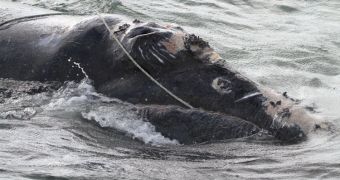For a long time, experts have been saying that preventing whales from getting entangled in fishing nets is a whole lot more efficient at ensuring the animals' survival than intervening to disentangling them.
This idea was again confirmed in Florida recently, when a right whale was observed floating dead in waters off St. Augustine. The animal could not be saved, as it was already dead when it was discovered.
Scientists do admit that interventions to save entangled whales provide the animals with a much better chance at survival than if they were left to disentangle themselves. However, the method is not foolproof, and therefore new solutions need to be devised.
The Florida whale died on February 1, when it was noticed by an aerial survey team from Florida Fish and Wildlife Conservation Commission (FFWCC). After being towed on a nearby beach, experts got ready to perform a necropsy (animal autopsy).
Representatives from numerous state and local agencies gathered to witness the event, as did scientists from academic institutions and nonprofits organizations. Barb Zoodsma, a scientist with the US National Oceanic and Atmospheric Administration (NOAA), also attended the necropsy.
The reason why this animal was given so much attention is that it was a member of a species called North Atlantic right whales. Only 300 to 400 individuals from this species are believed to be alive around the world, and so they are considered critically endangered.
In other words, conservationists and authorities are looking for any potential measure they could take to ensure that these animals are no longer killed by negligence – most often by fishing net entanglement and collision with ships.
“Led by necropsy team leader, William McLellan of University of North Carolina Wilmington, and assisted by Dr. Michael Moore, Woods Hole Oceanographic Institution, and Alex Costidis, University of Florida, scientists examined this 31 foot, 15,000 pound whale for clues to its demise,” a NOAA report says.
“Numerous lesions from its long term entanglement and shark bites were examined thoroughly, and tissue samples from the wounds will be shipped to labs for further study. The final results of the necropsy will depend on these analyses and will not be available for some time,” the document adds.
The necropsy concluded that the whale was malnourished due to ropes that had become entangled in its mouth, preventing it from feeding. This made it underweight, and an easier prey for sharks.
Experts believe that numerous shark bites to the carcass are the most likely cause of death, as some of them were found on major veins at the base of the whale's tail. It took several months for the animal to die, in horrible pains, and conservationists are determined not to see this happening again.

 14 DAY TRIAL //
14 DAY TRIAL //